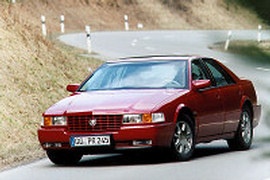CADILLAC Seville Models/Series Timeline, Specifications & Photos
First production year: 1992
Engines: Gasoline
In 1997, Cadillac was ready to attack the European market and produced the Seville as a contender for the BMW 7-Series and the Mercedes-Benz S-Classe.
While the European brands were cutting big chunks of the U.S. premium car-market, Cadillac was in a defensive position, but still, lead the segment. But GM didn't give up and tried to hit them in their home market as well. It even obtained a type approval number for the Seville and launched the car in Europe.
With its sleek design, the Seville was far from the rigid German design language. Its headlights looked narrow on that wide grille, and the raked windshield continued the aerodynamic theme. In the back, Cadillac abandoned the vertical windscreen and installed a raked-forward one. Its designer tried to make a shorter trunk, but not too short.
Inside, it was luxurious. It was on par with the leading competitors from Audi, BMW, and Mercedes-Benz in terms of the front seats. The curved dashboard design and the green illumination for the instrument panel invited the driver to embark on long journeys and spend more hours at the wheel. The specially designed power-seats weighed and calculated the driver's size and adjusted the bolstering and the seatback for better support. But the raked-forward windscreen led to a smaller rear room for passengers. There was not enough headroom or legroom. The front seats were just too thick, and the bench was not that slim either.
While the leading European premium carmakers were focused on a real-wheel-drive solution, Cadillac chose a front-wheel-drive drivetrain. The same system was used by Audi as well. But unlike the four-ringed carmaker, the Seville featured a transverse, 4.6-liter V-8 engine. Its Magna-ride electronically controlled suspension offered a comfortable ride, but it stiffened on curves to improve handling.
To beat the European premium carmakers, Cadillac introduced a completely new Seville in 1992 and built it in the European style.
Long, sleek, and with a sportier look, the 1992 Seville was a far departure from its regular design language. The transition to the front-wheel-drive system was a process that Cadillac didn't master yet, but that didn't make them abandon the idea.
From the exterior, the Seville sported the same flat, vertical grille but dressed in body color instead of chrome, although that was an option for those who liked it the old-fashioned way. The cab-forward design was amplified by the very sloped rear windscreen and the long-wheelbase from its sides. Cadillac installed an LED strip across the entire trunk lid as a third brake light in the rear.
Inside, the transverse, front-mounted engine left room for a roomier interior. At the front, the bucket seats were available with power adjustments and leather upholstery. The carmaker moved the steering-column shifter on the center console in the European and Japanese style. Cadillac redesigned the dashboard, which featured a unitary design and an instrument cluster extended over the center stack. The on-board computer buttons and climate controls flanked the instrument panel. In the rear, the bench was profiled for two passengers and offered plenty of legroom and headroom.
Under the hood, GM installed the old 4.9-liter V-8 push-rod. Later on, it introduced the Northstar V-8 unit with over-head camshafts. For the transmission, the Seville featured a standard four-speed automatic. To stop the heavy sedan, the car featured disc-brakes in all corners. Unfortunately, the car had a very heavy nose, and that led to longer stopping distances.

